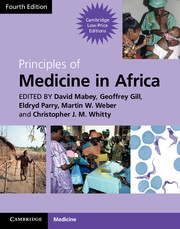Book contents
- Frontmatter
- Contents
- Contributors
- Foreword
- Section 1 Health and disease
- Section 2 Mother and child health
- Section 3 Infection: general principles
- Section 4 Major common infections
- Section 5 Bacterial infections
- Section 6 Viral Infections
- Section 7 Protozoal infections
- Section 8 Helminth infections
- 46 Intestinal helminths
- 47 Schistosomiasis
- 48 Lymphatic filariasis and loa loa
- 49 Onchocerciasis
- 50 Cysticercosis
- 51 Hydatid disease
- 52 Paragonimiasis
- 53 Trichinellosis
- 54 Guinea worm
- Section 9 Fungal infections
- Section 10 Non-communicable diseases
- Section 11 Diseases of body systems
- Section 12 Cancer and Palliative Care
- Section 13 Venoms and Poisons
- Index
- References
48 - Lymphatic filariasis and loa loa
from Section 8 - Helminth infections
Published online by Cambridge University Press: 05 March 2013
- Frontmatter
- Contents
- Contributors
- Foreword
- Section 1 Health and disease
- Section 2 Mother and child health
- Section 3 Infection: general principles
- Section 4 Major common infections
- Section 5 Bacterial infections
- Section 6 Viral Infections
- Section 7 Protozoal infections
- Section 8 Helminth infections
- 46 Intestinal helminths
- 47 Schistosomiasis
- 48 Lymphatic filariasis and loa loa
- 49 Onchocerciasis
- 50 Cysticercosis
- 51 Hydatid disease
- 52 Paragonimiasis
- 53 Trichinellosis
- 54 Guinea worm
- Section 9 Fungal infections
- Section 10 Non-communicable diseases
- Section 11 Diseases of body systems
- Section 12 Cancer and Palliative Care
- Section 13 Venoms and Poisons
- Index
- References
Summary
The problem in Africa
Lymphatic filariasis is a leading cause of permanent and long-term disability. It will continue to be a major problem in some areas of Africa for many years to come. The outlook for the control of lymphatic filariasis has, however, markedly improved recently. In the long term, filariasis is a potential candidate for elimination from Africa.
Loiasis exclusively occurs in Africa where millions of people are infected. In some endemic regions it is one of the commonest causes for medical consultations. Loiasis has recently gained attention due to severe complications observed in individuals co-infected with O. volvulus who were treated with antifiarial drugs.
Organism, life cycle and vector
Both lymphatic filariasis and loiasis are vector-borne infections caused by filarial nematodes.
In Africa lymphatic filariasis is almost exclusively caused by Wuchereria bancrofti. Microfilariae of W. bancrofti are ingested by female mosquitoes (Anopheles, Culex and Aedes spp.) during feeding. L.loa is transmitted by small blood-sucking Chrysops-flies, that live in or near forested and muddy areas.
- Type
- Chapter
- Information
- Principles of Medicine in Africa , pp. 453 - 456Publisher: Cambridge University PressPrint publication year: 2013



